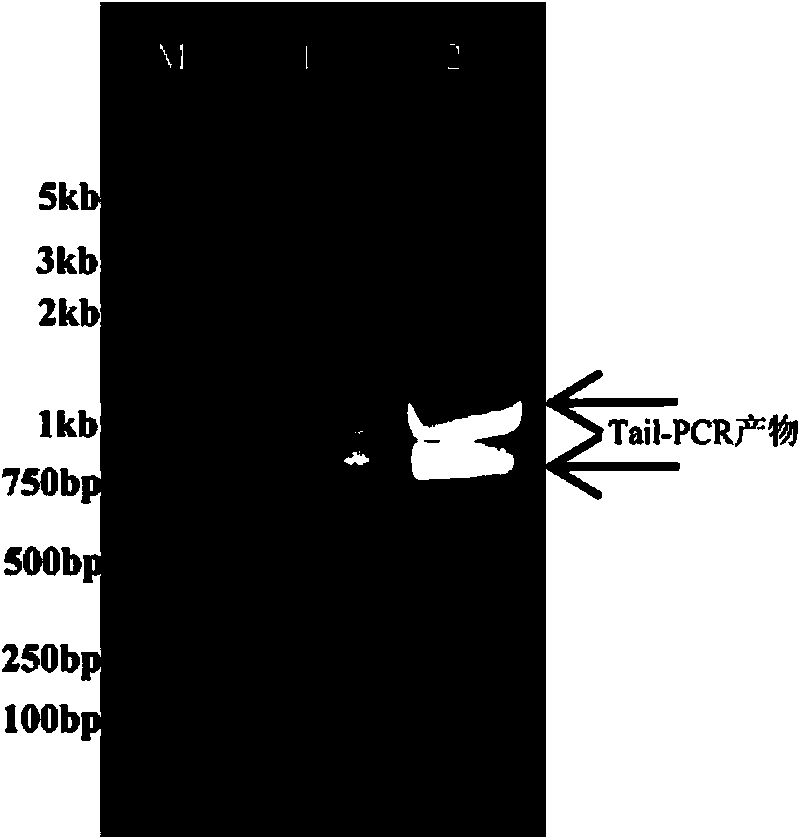High-glyphosate-tolerance EPSP synthase (5-enolpyruvylshikimate-3-phosphate synthase), and coding gene and application thereof
An EPSP synthase and gene technology, which is applied in the field of biology, can solve the problems of decreased glyphosate inhibition constant, decreased binding ability, decreased PEP affinity, etc.
- Summary
- Abstract
- Description
- Claims
- Application Information
AI Technical Summary
Problems solved by technology
Method used
Image
Examples
Embodiment 1
[0108] Example 1 Screening and identification of resistant strains
[0109] Soil samples heavily polluted by glyphosate were serially diluted with liquid M9 medium, and the dilution factor was 10 6 The soil suspension was spread on the M9 solid medium containing 300mM glyphosate, and cultured at 37°C. Since the M9 medium is auxotrophic, the bacteria that can survive and grow are glyphosate-resistant strains. Use liquid M9 medium containing 300mM glyphosate to verify the glyphosate resistance of the screened strains again, and use plasmids pACYC-HTG7, pACYC-AM79, pACYC-A1501, pACYC-RD, pACYC-G2 to transform the recombinant of ER2799 strains as control (Cao G, Liu Y, Zhang S, Yang X, Chen R, Zhang Y, Lu W, Wang J, Lin M, Wang G: A novel 5-enolpyruvylshikimate-3-phosphate synthase shows high glyphosate tolerance in Escherichia coli and tobacco plants. PLoS ONE2012,7(6):e38718). Such as figure 1 As shown, 1, 2, 3, 4, and 5 respectively represent recombinant strains containing ...
Embodiment 2
[0118] Example 2 Cloning of the gene encoding P818EPSPS (i.e. the gene encoding EPSP synthase, abbreviated as aroA818)
[0119] By analyzing the relevant EPSPS coding gene sequences, designing universal primers or degenerate primers according to the conserved sequences, and using thermal asymmetric PCR (Tail-PCR) method, the EPSPS coding genes were cloned.
[0120] The nucleotide sequence and amino acid sequence of EPSPS coding genes derived from microorganisms with known sequences were compared to analyze their sequence conservation at two levels. According to the principle that bases with slightly more occurrences are selected, the reverse primer was designed as an anchor primer, P818-universal-R: 5'-GTAATACGACTCACTATAGGCATGGCGATGCGATGATC-3' (SEQ ID NO.5); the forward primer was designed to merge Primer, P818-random-F: 5'-GTAATACGACTCACTATAGGAADMGNCC DWTDRR-3' (SEQ ID NO.6), the sequence of the T7 promoter is added to the 5' end of the primer to facilitate the next experimen...
Embodiment 3
[0125] Example 3 Similarity between P818EPSP synthase and other known glyphosate-resistant EPSP synthases
[0126] The EPSPS encoding gene aroA818 of Pseudomonas P818 has a full length of 1323bp and encodes 440 amino acids. Collect typical partial EPSPS sequences with a certain research basis and use the Neighbor-Joining algorithm to construct a phylogenetic tree (MEGA4.0), with a bootstrap value of 1000 times.
[0127] Phylogenetic analysis showed that AroA818 belongs to type II EPSPS, which has the closest homologous relationship with the EPSPS of Pseudomonas stutzeri A1501 ( image 3 ).
PUM
 Login to View More
Login to View More Abstract
Description
Claims
Application Information
 Login to View More
Login to View More - R&D
- Intellectual Property
- Life Sciences
- Materials
- Tech Scout
- Unparalleled Data Quality
- Higher Quality Content
- 60% Fewer Hallucinations
Browse by: Latest US Patents, China's latest patents, Technical Efficacy Thesaurus, Application Domain, Technology Topic, Popular Technical Reports.
© 2025 PatSnap. All rights reserved.Legal|Privacy policy|Modern Slavery Act Transparency Statement|Sitemap|About US| Contact US: help@patsnap.com



